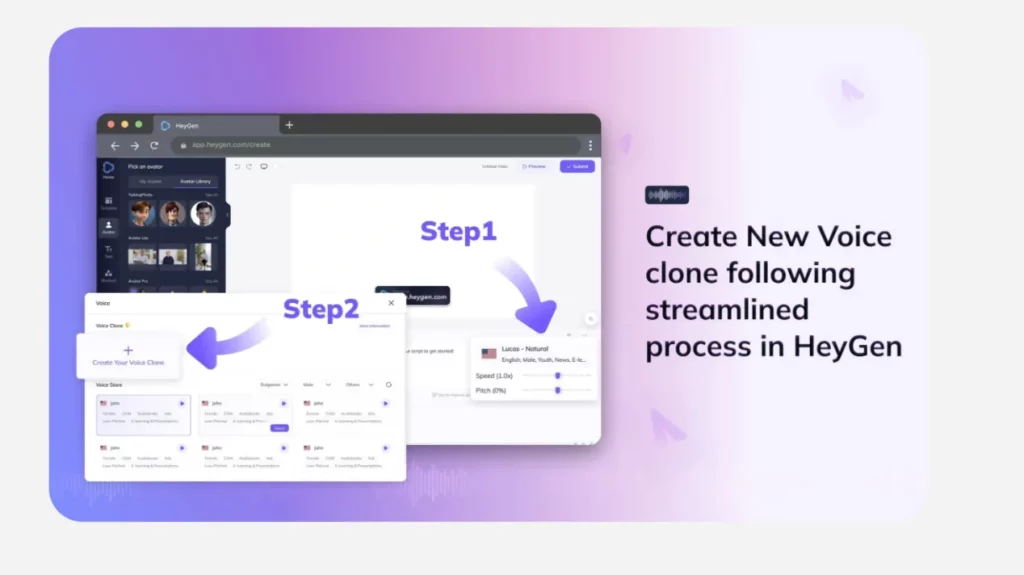Voice Cloning: The Future of Content or Privacy Nightmare?
Surprising but true – AI is now cloning our voices! Tools like Wav2Lip, Descript, and Play.ht are revolutionizing content creation with synthetic speech and lip-syncing tech. 🎙️🔮
They're not just for sci-fi movies anymore. These tools are rapidly changing the game in education, entertainment, podcasting and beyond. But what about privacy? Are we ready to deal with the ethical issues tied to misuse?
Voice cloning? It's exactly what it sounds like. AI uses audio data to create a synthetic version of a specific person's voice. Originally made to assist those who've lost their voice, now it's fueling personalized digital assistants and realistic text-to-speech systems.
Lip-syncing? It's all about syncing mouth movements with a pre-recorded audio track. The result? It looks like the character is genuinely speaking or singing. It's a delicate dance of studying mouth shapes, breathing, and facial expressions. The best part? It connects emotionally with the audience like never before.
In this piece, we'll explore these innovative tools, their role in contemporary synthetic voice creation, and their potential impact on the future of communication and entertainment.
Understanding Voice Cloning
Voice cloning, a type of artificial intelligence, creates synthetic speech that closely mimics a specific person's voice. This technology works by collecting audio data, feeding it into a neural network, and analyzing the audio to recreate the person's voice. Initially developed for various applications like audiobooks and assisting those who have lost their voices, it has also found commercial use in creating personalized digital assistants and natural-sounding text-to-speech systems.
Exploring Lip-Syncing
Lip-syncing is the process of synchronizing mouth and facial movements to match a pre-recorded audio track, creating the illusion that the character is actually singing or speaking. It brings multimedia content to life by seamlessly marrying the visual and audio elements. Lip-sync animators carefully study mouth shapes, breathing, and facial expressions that correspond to different sounds in order to make each syllable look natural. The best lip-syncing blends art and technology to tell a story that resonates emotionally with the audience.
Most Popular AI Tools for Lip Syncing in 2024
Some of the popular AI tools available for lip-syncing are mentioned below:
1. Rask AI

Rask AI is an advanced artificial intelligence platform that automates video localization and dubbing. Its proprietary technology leverages speech-to-text, machine translation, and text-to-speech to translate videos into over 60 languages.
A key feature is Rask's voice cloning capability, which replicates a speaker's unique voice and speaking style in the translated version using AI synthesis. This maintains branding and tone consistency across languages. Rask also offers lip sync to align mouth movements with the dubbed audio track for a more natural viewing experience. These AI advancements save significant time and cost for creating multilingual video content at scale.
Rask Ai Pricing:
Rask AI offers several pricing plans starting from $9 per month. For larger needs, additional minutes can be purchased for $1-2 per minute depending on the plan.
2. HeyGen

HeyGen leverages cutting-edge artificial intelligence to revolutionize video creation and localization. Its innovative voice cloning capability uses advanced deep learning to clone a speaker's unique voice with remarkable accuracy. This enables consistent branding and communication across translated video content.
Additionally, HeyGen's lip sync technology synchronizes lip movements to match the dubbed language, delivering a smooth viewing experience. Underpinning these features is HeyGen's proprietary text-to-speech engine that generates high-fidelity synthetic voices, enhancing accessibility. With its AI-powered voice cloning, seamless lip syncing and synthetic voice generation, HeyGen brings unparalleled quality and efficiency to video creation and localization.
Based on the official site and other sources, here are the key features of HeyGen AI
HeyGen Pricing:
HeyGen AI offers a free plan with limited features, and its paid plans start at $29 per month for the Creator plan, which includes 15 credits per month.
3. Wav2Lip

Wav2Lip is another groundbreaking AI tool that brings a new level of realism to video content. It uses advanced deep learning algorithms to clone voices, enabling the creation of synthetic voices that closely mimic the original speaker's tone and style. This technology is not limited to just voice cloning, it also excels in lip-syncing. Wav2Lip can accurately synchronize lip movements with the cloned or original voice, creating a seamless and realistic viewing experience.
This high level of accuracy is achieved even in dynamic, unconstrained videos, making it a versatile tool for various applications.
Furthermore, Wav2Lip is capable of working with any identity, voice, and language, and even CGI faces, making it a truly universal solution for voice cloning and lip-syncing needs.
Wav2Lip Pricing:
Wav2Lip, is an open-source project and does not have a specific pricing model for individual use. However, for commercial licensing or integration into a product, users are advised to contact the developers directly.
Additionally, a related service, NeuralSync AI, offers lip-sync technology at a cost of 3-4 dollars per minute for a simple talking head, and up to 10 dollars per minute for dynamic scenes with multiple actors
Most Popular AI Tools for Voice Cloning in 2024
Here are the Popular AI Tools for Voice Cloning:
1. Descript

Descript is often cited as one of the best all-around voice cloning tools. It provides comprehensive audio and video editing features, including a voice cloning feature that allows users to edit audio by adjusting the corresponding text transcript. Descript's AI-based tool is known for its ease of use and has been influential in changing the editing experience for many users.
2. Respeecher

Respeecher is highly regarded among filmmakers, game developers, and content creators for its ability to generate accurate voice clones that are difficult to distinguish from the original. It offers a wide range of customizations, including the ability to instill various emotions and characteristics into the cloned voice.
3. Murf AI

Murf AI is another voice cloning software that has gained popularity for its straightforward pricing and the ability to produce high-quality voiceovers. It is designed to cater to a variety of use cases, including professional voiceovers for products or services, and can clone voices with a specific vocal tone.
4. Play.ht

Play.ht leverages advanced artificial intelligence to offer revolutionary text-to-speech and voice cloning capabilities. Its innovative technology can clone a speaker's unique voice from just 30 seconds of audio, enabling consistent branding across translated content. Furthermore, play.ht is pioneering lip-sync technology that automatically synchronizes lip movements to match the cloned or synthetic voice, creating seamless and natural speech flows.
Underpinning these features is play.ht's proprietary text-to-speech engine that generates ultra-realistic synthetic voices, enhancing accessibility and user experience. With its AI-powered voice cloning, automatic lip-syncing and synthetic voice generation, play.ht is leading the way in speech technology innovation.
Step-by-Step Guide to Cloning Voice and Lip-Syncing
Creating a voice clone and achieving lip-syncing with AI involves a series of steps that leverage machine learning algorithms and sophisticated AI tools. Here's a step-by-step guide to help you understand the process:
Cloning Voice with AI
- Select a Tool: Choose a voice cloning tool like Descript, Murf AI, Respeecher, or Play.ht Voice Cloning.
- Collect and Upload Voice Data: Gather high-quality voice recordings of the person whose voice you want to clone and upload them to the chosen software.
- Train and Refine the AI Model: The AI algorithms will analyze the recordings, create a custom voice model, and generate synthetic voices. Make necessary adjustments to improve the quality.
- Use the Cloned Voice: Input text into the software to recreate the voice for various applications.
Lip-Syncing with AI
- Choose a Tool: Select a lip-syncing tool like Rask AI, HeyGen, or Wav2Lip.
- Record or Import Audio: Record the audio you want to lip-sync to or import an existing audio file into your project.
- Sync Audio to Video: Add the audio file to your video editing software and align it with the video track.
- Refine the Lip-Sync: Use the software's tools to fine-tune the lip-sync, adjusting the timing of the audio or editing the video to better match the audio.
Remember, both voice cloning and lip-syncing with AI require practice and patience. But with the right tools and dedication, you can create impressive results.
Ethical Considerations in Voice Cloning and Lip-Syncing
Here are some key considerations regarding the ethical implications of voice cloning and lip-syncing technology:
Top FAQs on How to Clone Voice and Lip-Sync
What are the steps involved in lip-syncing?
What are the potential applications of voice cloning and lip-syncing?
Is voice cloning legal, and what are the ethical considerations?
How can I use voice cloning and lip-syncing for my business?
Recommended Readings:
Conclusion
In conclusion, voice cloning and lip-syncing are powerful tools that can revolutionize content creation, dubbing, and localization. They offer endless possibilities, from enhancing accessibility to pushing creative boundaries. However, it's crucial to use these tools responsibly, considering privacy, consent, and potential misuse. As we continue to explore this technology, we encourage you to experiment and discover its potential. How will you use voice cloning and lip-syncing in your projects?
How do you feel about AI cloning your voice? Excited or creeped out?















